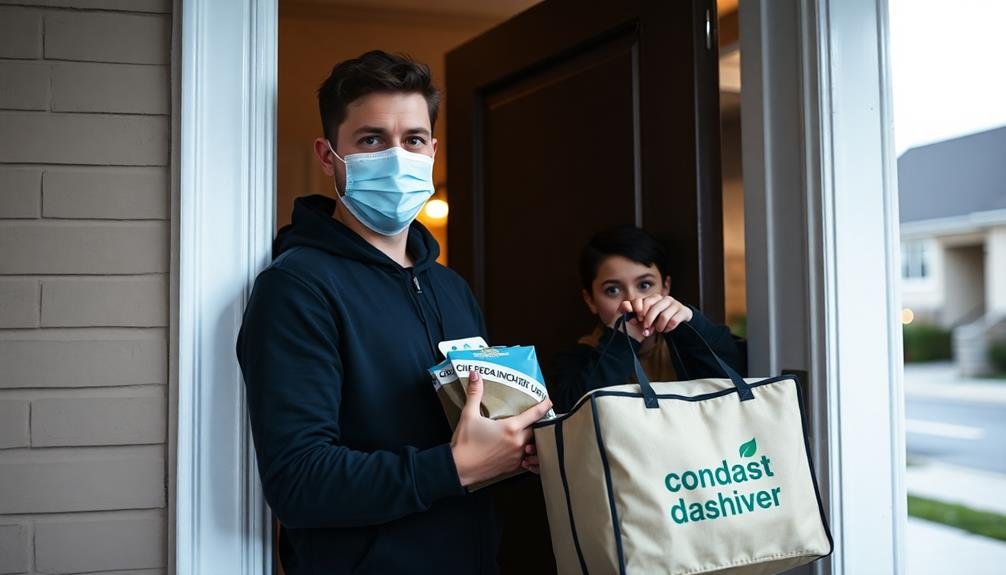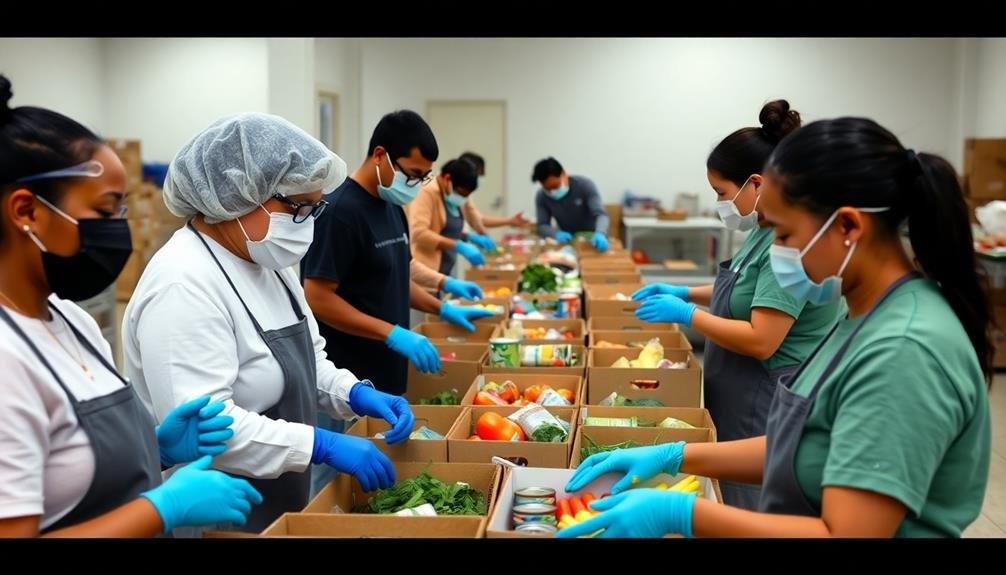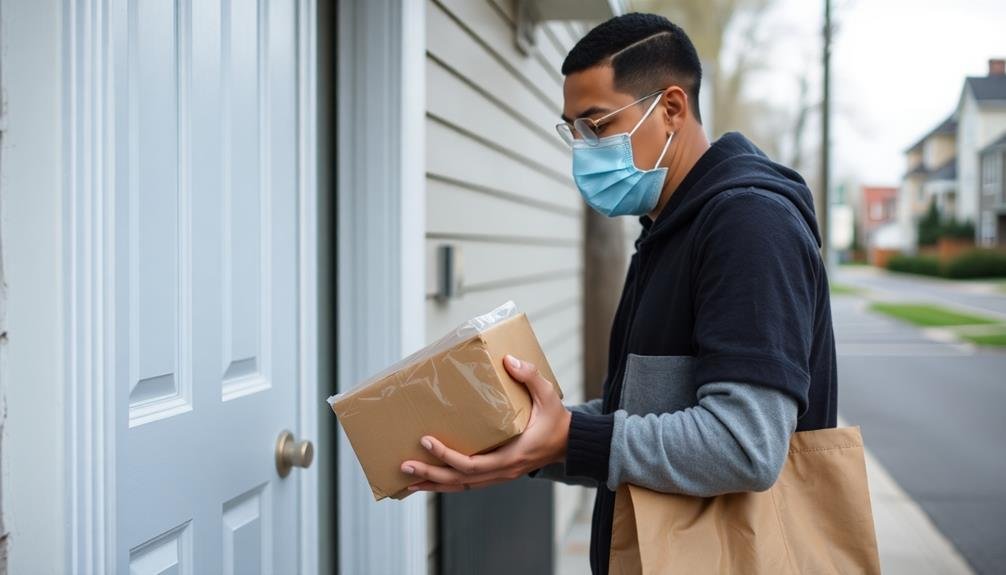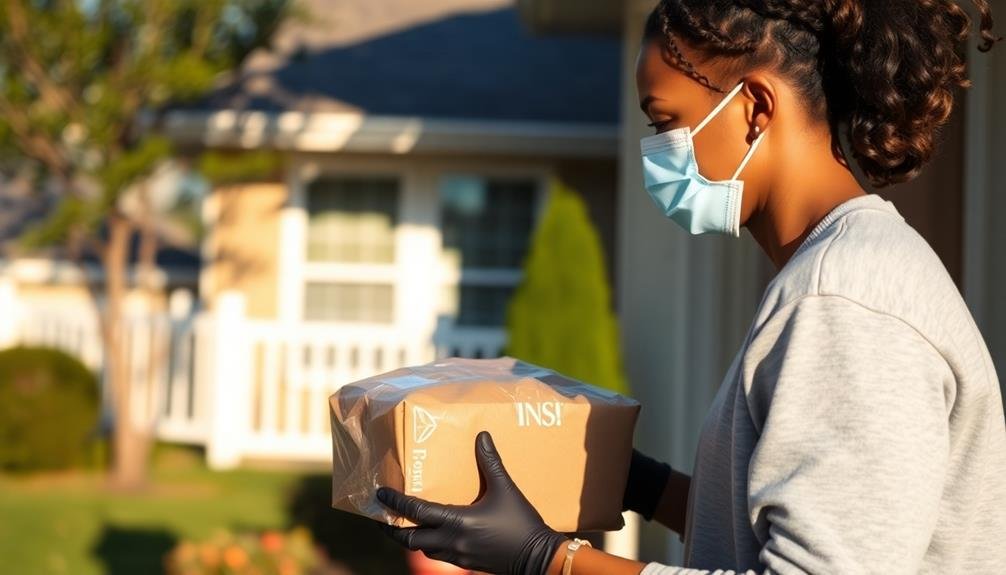Meal delivery volunteering can be an anxiety-friendly way to give back to your community. You'll provide essential support to vulnerable individuals while benefiting from structured tasks and controlled social interactions. To start, research local organizations with good safety protocols and flexible schedules. Prepare for your first shift by familiarizing yourself with guidelines and gathering necessary items. During deliveries, use coping strategies like deep breathing and positive self-talk. Build confidence gradually by starting small and celebrating personal victories. With time, you may even expand your role within the organization. By taking it step-by-step, you'll discover how rewarding this experience can be for your mental health and personal growth.
Understanding Meal Delivery Volunteering

Volunteering for meal delivery services provides an essential lifeline to those in need within your community. As a meal delivery volunteer, you'll play an important role in ensuring that vulnerable individuals, such as the elderly, disabled, or those facing financial hardships, receive nutritious meals regularly. This service helps combat food insecurity and promotes better health outcomes for recipients.
Your responsibilities typically include picking up prepared meals from a designated location, following a predetermined route, and delivering meals directly to recipients' homes. You'll need to adhere to food safety guidelines, maintain proper hygiene, and handle meals with care to prevent contamination.
Additionally, you may be required to perform brief wellness checks on recipients, noting any concerns to the organizing agency.
Meal delivery volunteering offers flexibility regarding time commitment. You can choose to volunteer weekly, bi-weekly, or on a more occasional basis, depending on your availability.
This type of volunteering is ideal for those who enjoy driving, have reliable transportation, and want to make a tangible difference in their community without extensive training or long-term commitments.
Benefits for Anxiety Sufferers
Three key benefits make meal delivery volunteering an excellent choice for those struggling with anxiety. First, it provides a structured activity with clear goals and expectations, helping you focus on a specific task rather than your worries.
Second, it offers controlled social interaction, allowing you to engage with others in a limited, predictable manner.
Third, it gives you a sense of purpose and accomplishment, boosting your self-esteem and reducing negative self-talk.
You'll find that meal delivery volunteering can be an effective way to manage your anxiety while making a positive impact on your community. By participating in this activity, you're not only helping others but also developing valuable coping skills.
You'll learn to:
- Navigate new environments with increased confidence
- Improve your time management and organizational skills
- Enhance your ability to communicate effectively in brief interactions
- Build resilience by facing small challenges and overcoming them
As you continue volunteering, you may notice a gradual reduction in your anxiety symptoms. The combination of routine, social connection, and meaningful contribution can create a powerful therapeutic effect, helping you feel more grounded and in control of your emotions.
Choosing the Right Organization

To find the best meal delivery volunteer opportunity, you'll want to start by researching local organizations in your area.
Look for established programs with a track record of community service and positive testimonials.
As you narrow down your options, carefully evaluate each organization's safety protocols to guarantee they prioritize volunteer well-being and follow proper food handling procedures.
Research Local Volunteer Opportunities
Selecting the right organization for meal delivery volunteering is essential for a rewarding experience. To find the best fit for your anxiety-friendly volunteering, research local opportunities thoroughly.
Start by exploring online platforms like VolunteerMatch or local community websites that list various meal delivery programs. Don't hesitate to reach out directly to organizations you're interested in, asking about their volunteer requirements and any accommodations they offer for individuals with anxiety.
Consider these factors when researching volunteer opportunities:
- Flexibility in scheduling and commitment levels
- Training and support provided for new volunteers
- Safety protocols and contactless delivery options
- Opportunities for gradual involvement or shadowing experienced volunteers
Once you've identified potential organizations, take time to read reviews or testimonials from current or past volunteers. This can give you valuable insights into the organization's culture and how they treat their volunteers.
If possible, attend an information session or orientation to get a firsthand feel for the organization and its staff. Remember, it's okay to try out different opportunities before committing long-term. Your comfort and well-being should be a priority in your volunteering journey.
Evaluate Organization's Safety Protocols
During your search for a meal delivery volunteer opportunity, evaluating an organization's safety protocols is essential, especially if you're managing anxiety. Look for organizations that prioritize volunteer safety and have clear, thorough guidelines in place.
Start by reviewing the organization's website or contacting them directly to inquire about their safety measures. Check if they provide personal protective equipment (PPE) like masks, gloves, and hand sanitizer. Verify they've strict hygiene protocols for food handling and packaging.
Ask about their delivery procedures. Do they offer contactless delivery options? Are there specific guidelines for maintaining social distance during deliveries? Inquire about their screening process for both volunteers and meal recipients to minimize health risks.
Consider the organization's training program. Do they offer detailed safety training for volunteers? Look for organizations that provide clear instructions on proper food handling, hygiene practices, and emergency procedures.
Don't hesitate to ask about their insurance coverage for volunteers. Knowing you're protected can help alleviate anxiety.
Preparing for Your First Shift
Getting ready for your first meal delivery shift can feel intimidating, but with the right preparation, you'll be set up for success. Start by familiarizing yourself with the organization's guidelines and safety protocols. Double-check the shift details, including the start time, location, and any specific instructions.
Gather all necessary items the night before. This typically includes:
- Your volunteer ID or badge
- A fully charged phone with the organization's contact information
- Comfortable, weather-appropriate clothing and shoes
- Hand sanitizer and face masks
On the day of your shift, arrive early to allow time for parking and checking in. Listen carefully to the coordinator's briefing and ask questions if anything is unclear. They'll provide you with the delivery route, recipient information, and any special instructions.
Before heading out, verify you have all the meals and any additional items (like utensils or condiments) for each recipient. Familiarize yourself with the route and use a GPS app if needed.
Remember to stay calm and focused during your deliveries. If you encounter any issues or feel overwhelmed, don't hesitate to contact the volunteer coordinator for support.
Coping Strategies During Deliveries

While preparation is key, you'll likely face unexpected challenges during your meal deliveries. To manage anxiety and stress, try these coping strategies:
- Deep breathing: Take slow, deep breaths to calm your nerves.
- Positive self-talk: Remind yourself of your capabilities and the importance of your work.
- Focus on one task at a time: Break down the delivery process into manageable steps.
If you encounter difficult situations, remember these techniques:
| Scenario | Coping Strategy | Expected Outcome |
|---|---|---|
| Wrong address | Stay calm, contact coordinator | Receive correct information |
| Unfriendly recipient | Maintain politeness, keep interaction brief | Complete delivery professionally |
| Traffic delays | Use GPS for alternative routes | Arrive at destination on time |
Don't hesitate to reach out to your volunteer coordinator if you're feeling overwhelmed. They're there to support you and can offer guidance or arrange for a partner to accompany you on future deliveries.
Building Confidence Over Time
Building your confidence as a meal delivery volunteer is a gradual process that requires patience and persistence.
You can start with small, manageable steps, such as familiarizing yourself with the delivery routes or practicing your interactions with recipients.
Don't forget to incorporate self-care techniques like deep breathing or positive affirmations, and remember to celebrate your personal victories, no matter how small they may seem.
Start With Small Steps
As you commence your meal delivery volunteering journey, it's essential to start with small steps to build confidence over time.
Begin by shadowing an experienced volunteer or staff member during your first few deliveries. This allows you to observe proper procedures and gain familiarity with the process without feeling overwhelmed.
Next, try handling a single delivery route with minimal stops. This gives you the opportunity to practice independently while managing a manageable workload.
As you become more comfortable, gradually increase the number of stops or take on more complex routes.
Don't hesitate to ask questions or seek support from coordinators or fellow volunteers. They're there to help you succeed and can offer valuable insights or reassurance when needed.
Remember, everyone starts somewhere, and it's okay to progress at your own pace.
Focus on these key points:
- Set realistic goals for each volunteer session
- Celebrate small victories and improvements
- Be patient with yourself as you learn
- Communicate openly about your comfort level
Practice Self-Care Techniques
Self-care techniques play an essential role in building up your confidence over time as a meal delivery volunteer. Prioritize activities that help you relax and recharge between shifts.
Try deep breathing exercises or meditation to calm your nerves before heading out. Engage in regular physical exercise to boost your mood and energy levels.
Create a pre-delivery routine that includes positive affirmations or visualizations of successful interactions. This can help you approach each delivery with a more confident mindset.
Don't forget to celebrate your small victories and progress along the way. Set boundaries and learn to say no when you're feeling overwhelmed. It's okay to take breaks or reduce your volunteering hours if needed.
Stay connected with fellow volunteers or join support groups to share experiences and coping strategies. Practice self-compassion and remind yourself that it's normal to feel anxious.
Focus on the positive impact you're making in your community. Keep a gratitude journal to reflect on the meaningful experiences you've had while volunteering.
Lastly, guarantee you're getting enough sleep and maintaining a balanced diet to support your overall well-being and resilience.
Celebrate Personal Victories
Throughout your journey as a meal delivery volunteer, it's crucial to recognize and celebrate your personal victories, no matter how small they may seem. These moments of success can help build your confidence and motivation, making future deliveries feel less intimidating.
Keep a journal or use a tracking app to record your achievements, such as completing a delivery without anxiety or interacting positively with a recipient.
Set realistic goals for yourself and acknowledge when you've met or exceeded them. This could be as simple as making eye contact during a delivery or remembering to breathe deeply before ringing a doorbell.
Share your accomplishments with supportive friends, family, or fellow volunteers who understand your challenges.
To help you recognize and celebrate your personal victories, consider these ideas:
- Create a "victory jar" and add a note for each success
- Reward yourself with a small treat after completing a challenging delivery
- Share your progress on social media or with a support group
- Reflect on how far you've come by comparing your current experiences to your first delivery
Expanding Your Volunteer Role

Once you've become comfortable with your meal delivery volunteer role, you might want to explore additional ways to contribute. Consider taking on more responsibilities within your current organization. You could offer to coordinate routes, manage inventory, or train new volunteers.
These roles can help you develop leadership skills while staying within a familiar environment.
If you're ready for a bigger change, look into related volunteer opportunities. Food banks, community kitchens, or nutrition education programs often need help.
These roles can complement your meal delivery experience and broaden your impact on food security issues.
You might also consider advocating for the cause. Share your experiences on social media, write to local officials about food insecurity, or participate in fundraising events.
Your firsthand knowledge can be powerful in raising awareness and support.
Don't forget to assess your comfort level as you expand your role. It's okay to start small and gradually increase your involvement.
Frequently Asked Questions
Can I Volunteer if I Have Dietary Restrictions or Food Allergies?
Yes, you can volunteer with dietary restrictions or food allergies. It's important to inform the organization about your limitations. They'll likely find suitable tasks for you, ensuring your safety while allowing you to contribute meaningfully to the cause.
What if I Get Lost or Can't Find the Delivery Address?
If you get lost or can't find the address, don't panic. Use your GPS or a map app on your phone. Call the recipient or your volunteer coordinator for guidance. They're there to help you succeed.
How Do I Handle Interactions With Grateful or Emotional Recipients?
When recipients are grateful or emotional, you can smile and say "You're welcome" or "Happy to help." Keep interactions brief if you're uncomfortable. If they want to talk more, politely explain you have other deliveries to make.
Are There Background Checks or Specific Requirements for Meal Delivery Volunteers?
You'll typically need to pass a background check and meet specific requirements. These may include a valid driver's license, reliable transportation, and age restrictions. Some organizations require training sessions or health screenings. Check with your local program for details.
What Should I Do if I Accidentally Damage or Spill the Meal?
If you accidentally damage or spill the meal, don't panic. Immediately inform your coordinator or supervisor. They'll guide you on next steps. Be honest about what happened and offer to help remedy the situation if possible.
In Summary
You've taken an important step toward managing your anxiety while helping others. Remember, it's okay to start small and gradually expand your comfort zone. With each delivery, you're not just providing a meal—you're nourishing your community and yourself. Don't hesitate to communicate your needs to the organization. As you gain confidence, you'll find that meal delivery volunteering can be a rewarding way to challenge your anxiety and make a real difference.





Leave a Reply